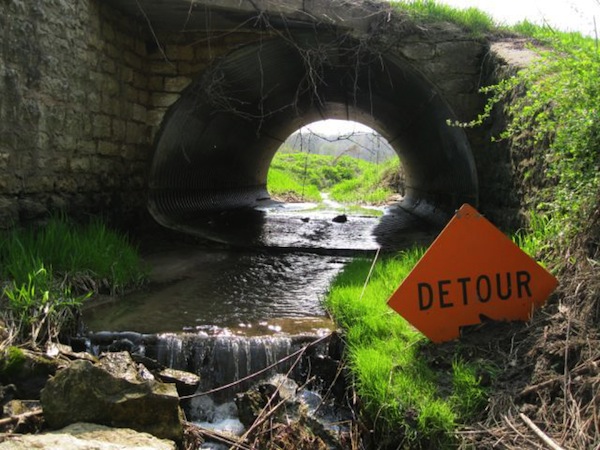Road block: Fixing aquatic ecosystem connectivity doesn’t end with dams

New UW research shows that roads and culverts can have a major impact on river and ecosystem restoration.
Over the last several years, state agencies and environmental nonprofit organizations have targeted dam removal as a way to quickly improve the health of aquatic ecosystems. Dams keep migratory fish from swimming upriver to spawn, block nutrients from flowing downstream, and change the entire hydrology of a watershed. From an ecosystem perspective, taking down a dam and returning a river to a more natural flow seems like a no-brainer.
In the study, published in the current issue of the journal Frontiers in Ecology and the Environment, the researchers mapped every obstacle — from large hydroelectric dams to tiny road culverts — in the entire Great Lakes drainage basin. What the maps show is that, while there are more than 7,000 dams on the rivers, creeks and streams flowing into the Great Lakes, there are 38 times that number of road crossings — or 268,818, to be precise.
Of course, many of those crossings are bridges with minimal impact on stream flow but, says Stephanie Januchowski-Hartley, lead author of the study and a postdoctoral researcher at the University of Wisconsin–Madison Center for Limnology, field studies in the Great Lakes region suggest that 64 percent of the road crossings could at least partially block fish movement.
“If you’re a state agency or a nonprofit group and you want to invest in river restoration and remove a dam, but you didn’t consider that, upstream, there are thirty road crossings and half of them are impassable, then you have a problem,” says Januchowski-Hartley. “You did do some good [by removing a dam], but to be most effective, you should think about all barriers.”
For example, many fish want to head as far upstream as possible to spawn in small tributaries during the spring. Taking a dam out of the main-stem river gives those fish more habitat to spend their adult lives in, but may not allow them to access preferred spawning habitat that’s crisscrossed by roads.
Water often shoots through the narrow corrugated metal tunnels of a road culvert so fast that fish can’t swim through. In steeper terrain, “perched culverts” essentially act like mini-dams, where water spills over a ledge into the stream below. Unless those fish are high-jumping salmon, any little ledge may be an obstacle.
Januchowski-Hartley says factoring road culverts and other smaller scale barriers into stream and river restoration can also make efforts more cost-effective.
“It helps save conservation dollars,” she says, “to better know the real costs [of habitat restoration] upfront, and not spend money on a project that’s only going to have limited impact.”
Januchowski-Hartley hopes having these maps available for state agencies and nonprofit groups will offer a “big picture” perspective on improving river access for migratory fish species.
Besides, she says, it’s less expensive to replace a road culvert than remove a dam. “In this region of the world, it seems like just about every road gets re-done in the spring,” she says, noting that there is ample opportunity to re-engineer a crossing that better fits a river or stream.
—Adam Hinterthuer
